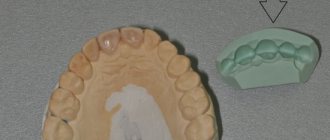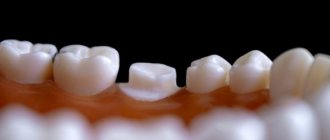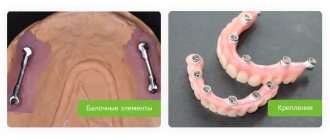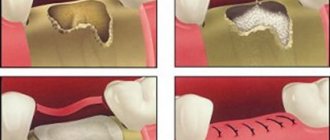What do we mean when we say “I want beautiful teeth”? In the world of ordinary things, “beautiful” most often means “noticeable, eye-catching.”
When we buy beautiful things, we expect that we will be able to attract the gaze of others, but with beautifully made teeth it is different. Beautiful teeth make the face attractive, if they are not obvious. Only you and the dentist know the secret to a renewed smile.
How to achieve such “inconspicuous beauty”?
Making a tooth both beautiful and inconspicuous means skillfully choosing the shape, surface relief and color. In this case, the restoration made will organically fit into the dentition, making the renewed smile beautiful and harmonious.
The main reason why a new tooth or restored part differs from natural teeth is a difference in color.
The fact is that we see objects and determine their color by the spectrum of light that they reflect. The path that light travels depends on the shape of the surface and the internal structure of the tooth.
The surface of a natural tooth has a complex macro- and micro-relief, and the internal structure is not uniform. Manufacturers of dental materials take into account the structural features of natural teeth and offer dentists and dental technicians materials that imitate the properties of enamel and dentin, of varying transparency and shades.
The layer-by-layer application of such materials allows you to create restorations that are as similar in structure to natural teeth and indistinguishable from them in color.
Restoration of a dental unit with a removed root
Modern dentistry has two ways to replace a tooth in place of an extracted root - implantation and prosthetics.
Table. Modern methods of replacing a tooth at the site of the extracted root.
| Name, photo | Short description |
| Implantation | The process begins with the implantation of a titanium pin into the gum, which is gradually fixed and overgrown with gum tissue. After a certain time, an abutment is put on it - an imitation of a tooth, and then a crown of the required texture and shade, making the artificial tooth almost impossible to distinguish from the “native” one. Young patients can undergo rapid implantation (in one day). If treated with care, the service life of a restored tooth is 10 years. Implants from leading foreign manufacturers are provided with a lifetime warranty. |
| Bridges | The technology we mentioned at the beginning of the article has come a long way in recent years. Now, instead of radical turning, methods are used using plates attached to the back walls of supporting teeth (adhesive bridges), special micro-locks and other more gentle and effective methods. Removable bridges on crowns are fixed according to the telescopic principle (one crown is fixed to the tooth, the other is put on the first one along with the prosthesis). This method is considered the most reliable. |
- How to deal with unpleasant odors in the home of a seriously ill person
Separately, it is worth highlighting replantation - an exclusive method of restoration by returning the original tooth to the socket. Such operations are performed quite rarely, only when a newly knocked out tooth is brought to the dentist.
Replantation of teeth
Is it so easy to put an invisible filling on a front tooth?
If the tooth is not very badly damaged, you will be offered to restore it with a filling. Aesthetic restorations made in one visit to a dentist are called “direct”.
The procedure for restoring a chipped part of a tooth seems simple, but it is not: the tooth is unevenly colored - it is darker at the gums, and almost transparent at the cutting edge. It will surprise you to know that teeth contain colors ranging from pink to blue, but the main shades are yellow, brown and gray.
Only with practice does a dentist develop an intuitive understanding of the sequence and which shades to use when layer-by-layer restoration of a particular tooth.
If you are interested, watch a video about how aesthetic restoration of the front teeth is done using Enamel plus material.
Implantation
Sometimes in a dentist’s practice there are more serious cases, for example, when a patient breaks two front teeth and damages the roots. In such situations, the restoration methods described above will not be able to give the desired result, so a more radical method is used - dental implantation. With its help, not only the visible part of the tooth is restored, but also the root itself, the role of which is played by the implant. Today there is a wide variety of implants, from budget to premium, but all of them are designed to perform the most important function - to transfer the chewing load to the bone, which will significantly reduce the rate of its atrophy.
Dental implantation takes place in a certain sequence and includes the following stages:
- Examination (visual inspection, targeted and panoramic photographs, etc.) and consultation.
- Implant installation.
- Installation of the gum former.
- Crown installation.
The steps described above can be performed in one or two stages, but the final result can only be discussed after the implant has completely engrafted. This process can take from several months to six months.
In cases where the patient does not go to the dentist for a long time and does not restore the broken front tooth, the bone tissue gradually atrophies (resorbs) due to lack of load. In the upper jaw, this process is faster, since the bone in this area is porous and more easily susceptible to irreversible changes. Sooner or later it will become thinner to such an extent that it will be impossible to install an implant. In such situations, another operation is performed - bone grafting, which allows you to increase the missing volume. However, in this case more time and financial resources will have to be spent on rehabilitation. Therefore, you should not ignore the problem; it needs to be resolved in a timely manner by a good dentist.
Features of aesthetic restoration of pulpless teeth
Some patients experience darker teeth after nerve removal.
To prevent a “dead” tooth from standing out among the “living” ones, the doctor can veneer the visible part with filling material. To do this, the top layer of enamel is removed and replaced with a lighter composite material. This is a fast and relatively inexpensive method of aesthetic restoration.
Despite the fact that modern filling materials make it possible to restore a tooth “without anyone noticing,” over time, by absorbing the dyes contained in food, composite restorations become visible and have to be replaced.
Recovery methods
Qualified dentists, who have a wide range of modern technologies, strive to save the patient’s tooth in any situation. If the root has received minor damage or remains intact, there is always a chance of restoration of the dental unit.
Dental restoration methods
Restoration methods are divided into two large categories - with and without root removal. The choice of technology depends on:
- general condition of the damaged tooth;
- square hemp;
- the presence or absence of an inflammatory process at the root;
- volume of hard tissues;
- gum conditions;
- the presence of chronic diseases in the patient.
If caries, inflammation in the root canals, or dentin rot are detected, the remains of the stump are removed. The unsatisfactory condition of the external tissues inevitably leads to damage to the internal segment of the tooth located in the gum. Softened fragments of dental tissue, damaged by caries and injured, crumble easily. It makes no sense to leave such problematic roots and use them as the basis for recreating a tooth; they must be removed.
Often, the removal procedure is complicated by the incorrect position of the root (crooked, horizontal) or the small size of the stump with the impossibility of grasping it with surgical forceps.
Prepared tooth stump for restoration
The process of removing the root of a broken tooth includes:
- opening of the gums;
- removal of remaining hard tissue. The treatment is carried out using a gentle method using ultrasound (trauma is reduced, the recovery period after the procedure is shortened);
- dividing the root into parts in complex clinical cases. Such an operation may be accompanied by complications (in particular, alveolitis - post-traumatic infection and inflammation of the tooth socket), and long-term rehabilitation.
Tooth root fragments. The fracture line is deep under the gum
What to do if there are several fillings on a tooth and you are tired of changing them
If you are tired of changing fillings, but want your tooth to always look “like new,” the best solution would be to install:
- ceramic veneer if the tooth is “alive”
- a ceramic crown if the tooth is pulpless
Aesthetic restoration of teeth with veneers and crowns are classified as “indirect” restorations, since they must be prepared in a dental laboratory before installation. Unlike “direct” restorations made from filling material, ceramic crowns and veneers will not change their color over time and will always look “like new.”
The ceramics from which crowns and veneers are made are close in optical properties to the enamel of natural teeth, so talented dental technicians manage to create teeth that are indistinguishable from natural ones. But in such dental restoration a new level of complexity appears: how to make sure that a dental technician who does not see the patient understands what color a veneer or crown needs to be made?
Using Lumineers
It acts as an analogue to veneers, but has a wider range of advantages, for example, the absence of turning. For more reliable fixation, it is enough to carry out surface grinding of the enamel. Also, these dental products are thinner, which increases the level of aesthetics and naturalness. They cost about 1.5 times more than veneers, but the result is worth it. Installation is very fast. The first session includes examination and sanitation of the oral cavity, as well as taking impressions. At the second session, lumineers are installed.
Teeth colors
This is where the color scale comes to the rescue, in which the teeth are divided into groups depending on the shades and their intensity.
It would seem that it would be difficult, given a scale, to find the desired color match. However, the choice is not as obvious as it might seem. Any surrounding colors, especially bright ones, from the patient’s makeup to the color of furniture and walls, disrupt the perception of shades.
The perception of colors is purely individual, and also deteriorates with age, so often when choosing a color, the doctor asks the opinion of the assistant and his colleagues. Lighting plays an important role in determining color (it can be artificial, natural or mixed).
Since the veneer and crown are placed on a ground tooth, it is necessary to predict what color this combination will produce.
Preparation for restoration: stages
If the patient has indications for such treatment, then:
- Examination and consultation with an orthopedic doctor who will help you choose the necessary recovery option.
- Carrying out additional diagnostics - computed tomography, which will allow us to examine all structures in detail and identify contraindications to this or that type of restoration.
- Professional oral hygiene performed by a dental hygienist. It consists of removing plaque, stones from the surface of the enamel, eliminating bleeding gums, etc.
- Treatment: sanitation of the oral cavity is necessary in order to eliminate foci of infection and caries.
- Whitening can be carried out before the restoration, since if it is carried out after, the color of the bleached teeth will not match the previously carried out restoration.
- The Vita scale is used: the orthopedic surgeon determines the color of the teeth.
Why a new tooth may be noticeable
It happens that when choosing a color among the reference teeth, you can find a surprisingly suitable one. The laboratory makes the restoration in accordance with the specified color, but it looks like a “stain” in the dentition. Most often this happens if the tooth is restored with a metal-ceramic crown, and the neighboring teeth are “alive”.
Above we talked only about ceramic veneers and crowns, but it happens that in order to reduce the cost of prosthetics, the patient chooses metal-ceramic crowns, the aesthetic properties of which differ from all-ceramic ones not for the better.
The metal from which the crown frame is made does not allow light to pass through at all, and the dental technician, by combining paints and shades, tries to create a feeling of depth and transparency.
The task of “matching the color” is simplified if you choose ceramics (lithium disilicate) or zirconium dioxide lined with ceramics for the production of restorations. These materials transmit light well, but there are difficulties with color selection in this case:
- reference teeth colors in the clinic and laboratory may not match
- During the manufacturing process, after firing, ceramics may change color slightly
- ceramic masses may vary in color depending on the batch
- Even an experienced dental technician is not always able to select the combination of ceramic masses necessary to obtain the desired color
technique of layer-by-layer application of Noritake ceramic mass
It is precisely the difficulties of production that explain why, after trying on crowns and veneers, they often have to be returned to the dental laboratory for revision.
How can you hide an extracted tooth (if there is no root)
- removable “butterfly prosthesis” (already discussed above),
- fixed classic bridge,
- adhesive bridge,
- prosthetics on implants.
Fixed bridge prosthesis
A classic bridge consists of several crowns connected together. The outer ones are fixed on the supporting teeth, the central one replaces the missing tooth (more precisely, its upper part - a natural crown). Such prosthetics are still very popular because... we can call it familiar to people and most practicing dentists. Although, in fact, it has no obvious advantages. After all, you have to grind and depulp the supporting teeth - this reduces their service life several times.
You need to understand that if you choose a conventional bridge, bone tissue atrophy under the “empty” crown will continue. The prosthesis itself will become uncomfortable over time. Plus, the supporting teeth will be overloaded and gradually collapse. As a result, in a few years the bridge will fall out, you will have to remove its supports and think about new prosthetics.
Adhesive bridge
An adhesive bridge is a temporary orthopedic structure, it is somewhat reminiscent of a traditional bridge, only instead of supporting crowns it has small wings that are glued to adjacent teeth. The aesthetics of the adhesive structure are quite good; the supports for it do not need to be ground (and if necessary, then to a minimum). But the big drawback is poor fixation. Even with moderate pressure, the adhesive “bridge” may fall off. And to glue it, you will need to visit the clinic.
Prosthetics on implants
When using implant prosthetics, the following happens: first, an implant is implanted in place of the missing tooth root. If there are no 2-3 roots, then each will be replaced with an implant. By the way, the implant can be implanted at once, i.e. immediately after tooth extraction - this saves time and money. After some time (from 1 to 6 months), a permanent crown is installed. These months are necessary for the implant to take root in the bone and fuse with it into a single whole. If you immediately put a crown on the implant and start biting or chewing food with it, it will move, and inflammation and rejection may also begin. In the meantime, the implantation takes place, the patient walks with a temporary prosthesis.
Read on the topic: why it is better to choose a crown on an implant - the advantages of the most modern type of prosthetics.
Dentures on implants do not have the main disadvantage of classical dentures - the bone under them does not atrophy. There is also no need to “spoil” neighboring good teeth by grinding, no need to remove “nerves” from them. Therefore, restoration on implants lasts much longer (not 5-7 years, but 10-15 years).
An important nuance - when using prosthetics in the “smile zone”, you can place a ceramic crown only if zirconium dioxide is used between the implant and the prosthesis). And in the chewing department, it is better to give preference to metal ceramics and zirconium dioxide - due to their increased strength.
The only disadvantages of implant prosthetics include the presence of some contraindications. For example, a ban or allergy to anesthesia, or if the bone has severely atrophied. First, it will need to be increased, and then an implant will be placed. And in terms of cost, installing a budget implant with a crown is quite comparable to a prosthetic bridge.
%akc72%
Types of damage and their complexity
All mechanical injuries can be divided into:
1. Dislocations are a fairly complex injury, which is characterized by the displacement of one tooth relative to the others.
2. Fractures are severe types of injuries. These include: cracks in the coronal part, chipped enamel, and root fractures. The method of treating and eliminating the problem depends on the specific case.
3. Bruises are the mildest type of all injuries. It is characterized by minor tissue damage, without displacement.
The main causes of damage are:
- caries;
— thinning of tooth enamel due to problems (diseases) in the human body, and as a consequence deformation of the tooth shape;
- large and sudden load on the front part of the jaw;
- direct blow or careless handling.










